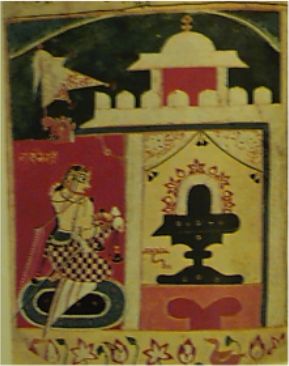Dear all, Giving the embroidery a place in history is a hazardous
case. Before Richard's embroidery I knew very litle about the subject. It
tickled my curiosity and I began reading, and looking for loose strings
that I could grab, in getting a very limited picture of the subject. The
thing that struck me most was Richard's information about the female input
in the embroideries being very important. If that's the case, the
embroideries can be more genuine then all the "Palace-carpets" together.
In my opinion "men" seem to bend history the way it suits them best, and
women don't. Women couldn't. Richard had a question about the cypresses. I
do not know how the cypress started as decoration, but there are cypresses
on 16th century Mughal paintings. In time, these cypresses are replaced by
the painters with more Indian, field filling, floral designs. Akbar tried
to construct "The Divine Belief", as he called it. It was a mix from Islam
and Hindu, and Akbar, being raised at the Persian court, had a sort of
liberal spirit. He was in dialog with western Jesuits also. So in this
case, the Art of Painting made use of Persian design and later on created
a more Indian, local Mughal style. The colors: In painting it's: yellow,
green, blue and red. It's the same with the colors found on the old
embroideries. On the image of the embroidery, it looks as if there are
softer colors. The design: The field is, I understood, unique. The tiles
do give me an earthly feeling, a feet on the ground perspective. This
isn't a Prayer-rug style of handling the design in an Islamic tradition.
The Ottomans: I can't find any real substantial influence on the art of
painting in India or Persia. The Islam had it's problems with the art of
painting. The Islam influence has been absorbed in the Mughal empires, but
substantial schools of the art of painting, didn't bother, because they
were the result of local, easily protected kingdoms. I hope my story will
tickle intrested in investigating the art of painting.  Malvaschool: Female in
adoration in front of the chapel of Shiva. Shiva is the god of destruction
(death/cypresses) and because of this a creator. Because he destroys in
order to create, he's also a fertiliser. So, what did I come up with: -The
tile-like design of the dark blue flowers look like, pomengrate-apples.
-The tile-like field, a putting things in perspective way of design. A
very common way of design in Indian painting to this day. -The phallus
symbol. -The cypresses. -The curtains/the niche not being an arch. -The
colors. Pink as extra? My impression (without handling, smelling, eating,
touching) the embroidery is: 19th century, female art, being more rooted
in the local Indian art tradition. Not Mughal, not Ottoman. But I'm sure,
a lot of you can tackle my findings. Please do so. Because if nobody
investigates, we'll be still out in the dark at the end of this salon. An
opportunity missed. Best regards, Vincent Malvaschool: Female in
adoration in front of the chapel of Shiva. Shiva is the god of destruction
(death/cypresses) and because of this a creator. Because he destroys in
order to create, he's also a fertiliser. So, what did I come up with: -The
tile-like design of the dark blue flowers look like, pomengrate-apples.
-The tile-like field, a putting things in perspective way of design. A
very common way of design in Indian painting to this day. -The phallus
symbol. -The cypresses. -The curtains/the niche not being an arch. -The
colors. Pink as extra? My impression (without handling, smelling, eating,
touching) the embroidery is: 19th century, female art, being more rooted
in the local Indian art tradition. Not Mughal, not Ottoman. But I'm sure,
a lot of you can tackle my findings. Please do so. Because if nobody
investigates, we'll be still out in the dark at the end of this salon. An
opportunity missed. Best regards, Vincent |
 Malvaschool: Female in
adoration in front of the chapel of Shiva. Shiva is the god of destruction
(death/cypresses) and because of this a creator. Because he destroys in
order to create, he's also a fertiliser. So, what did I come up with: -The
tile-like design of the dark blue flowers look like, pomengrate-apples.
-The tile-like field, a putting things in perspective way of design. A
very common way of design in Indian painting to this day. -The phallus
symbol. -The cypresses. -The curtains/the niche not being an arch. -The
colors. Pink as extra? My impression (without handling, smelling, eating,
touching) the embroidery is: 19th century, female art, being more rooted
in the local Indian art tradition. Not Mughal, not Ottoman. But I'm sure,
a lot of you can tackle my findings. Please do so. Because if nobody
investigates, we'll be still out in the dark at the end of this salon. An
opportunity missed. Best regards, Vincent
Malvaschool: Female in
adoration in front of the chapel of Shiva. Shiva is the god of destruction
(death/cypresses) and because of this a creator. Because he destroys in
order to create, he's also a fertiliser. So, what did I come up with: -The
tile-like design of the dark blue flowers look like, pomengrate-apples.
-The tile-like field, a putting things in perspective way of design. A
very common way of design in Indian painting to this day. -The phallus
symbol. -The cypresses. -The curtains/the niche not being an arch. -The
colors. Pink as extra? My impression (without handling, smelling, eating,
touching) the embroidery is: 19th century, female art, being more rooted
in the local Indian art tradition. Not Mughal, not Ottoman. But I'm sure,
a lot of you can tackle my findings. Please do so. Because if nobody
investigates, we'll be still out in the dark at the end of this salon. An
opportunity missed. Best regards, Vincent